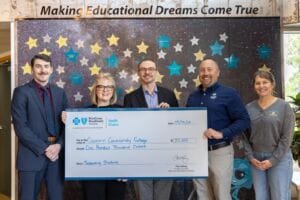With a growing number of technology companies, industry accolades and venture capital investments, Metro Phoenix is showing the rest of the world why it’s a top choice for innovation.
MORE NEWS: The 100 best doctors in Arizona for 2025
In just the past year, Arizona saw a massive expansion in its boisterous semiconductor industry. Taiwan-based Sunlit Chemicals opened its first U.S. factory in Arizona, which will be a crucial partner to other semiconductor companies in the state. The $100 million, 900,000-square-foot facility is expected to create more than 50 local jobs by early 2025.
Additionally, Taiwan Semiconductor Manufacturing Company (TSMC) announced a third fab location, bringing its total Arizona investment to $65 billion. With this also came the announcement of Halo Vista, a $7 billion, multi-use campus for workers and community members alike, something many real estate companies see as a win for their industry.
“Over the longer term, we expect to see growth across all major property uses in and around the TSMC site,” says Richard Mack, CEO of Mack Real Estate Group, the company developing Halo Vista. “We believe that demand for commercial space should lead naturally to demand for residential, hospitality, retail, restaurant, education and recreational spaces.”
It’s not just the semiconductor industry that’s thriving in the desert. Seven Arizona companies made the cut on Deliotte’s recently released North America Technology Fast 500 list. Lessen Software Services took the highest spot of the local companies, coming in at No. 3.
Phoenix also ranks among the top North American tech markets for office leasing activity this year, registering gains in both office rents and tech jobs, according to CBRE’s annual Tech-30 report. Among Tech-30’s leading submarkets, Tempe ranks nationally for net absorption from the second quarter of 2023 to the second quarter of 2024.
This doesn’t come as much of a surprise, given that tech companies accounted for 38.5% of Phoenix’s $162.5 million venture capital funding secured in the first half of 2024. And, with Tempe being home to Arizona State University (ASU) and other major tech companies, the market shows no signs of stagnation.
Why business leaders are betting on Arizona
Across industries, business leaders are recognizing Arizona’s variety of suitable factors.
“Keys to the Arizona tech ecosystem are multifold,” says Jack Selby, managing partner of AZ-VC. “Affordable cost of living, high quality of life, top-tier universities and proximity to California, which continues to send us amazing tech refugees.”
Sam Bertram, co-founder of vertical farming company OnePointOne, is one of the many tech founders who relocated his business to Arizona from California in recent years. He says that aside from the cost savings benefits across the board, he’s been impressed by Arizona’s vast network of pro-business groups.
“Resources to support OPO are everywhere, with the Greater Phoenix Economic Council chief among them,” Bertram says.
Chris Camacho, president and CEO of GPEC, has helped companies worldwide move to Arizona. He says that Phoenix has, in part, been able to continue attracting business leaders because his team has started to focus heavily on forecasting.
“Historically, [GPEC] was the promotion agency of the region, and that’s morphed to where we have to be the market futurists,” Camacho says. “These companies are trying to de-risk their investment, so we’re getting ahead of emerging trends and assessing key lever points in the market.”
There’s also a spirit of collaboration that continues to bolster successes Valley-wide.
“When we think about GPEC and the work Chris Camacho and his team at GPEC have done for the construction industry, and the state as a whole, the word that comes to mind is partnership,” says James Murphy, CEO of Willmeng. “They truly have the best interests of Arizona in mind when they are out getting deals done. The growth that we have experienced at Willmeng can be linked in many ways to the work that GPEC does to attract new businesses and we are grateful and proud to be a partner with them.”
As president of the PHX East Valley Partnership, John Lewis works with leaders across Tempe, Mesa, Chandler and other cities in the East Valley to provide synergy between the region.
He says fostering a collaborative environment is crucial for growth, given the sizeable economic overlap between these areas. He cites an example using Intel — although the company is located in Chandler, many employees will buy homes and shop in Gilbert.
“Rather than compete for business, our cities and towns lift each other up because they know that a win for one is a win for the entire region,” Lewis says.
Arizona business leaders say another key factor in driving economic growth and innovation are the efforts of Camacho and his team at GPEC.
“Even the most innovative business owners can struggle to decide where to plant their roots,” says David Hertzberg, Southwest geography leader for Olsson. “GPEC provides the guidance they need when deciding if Greater Phoenix is the right place for them. We at Olsson also pride ourselves on providing innovative guidance to our partners. We aren’t just thought leaders. We challenge norms and engineer new possibilities. Through our innovation incubator program, my Olsson colleagues and I are developing big ideas and practical solutions that will help our clients meet the challenges of today, tomorrow and 10 years from now.”
Answering the call
While the Greater Phoenix area has made great strides in recent years, industry power players see further opportunities to solidify Arizona as a top innovation market. Chief among these opportunities is a focus on technical skills.
“Our Arizona ecosystem needs more technical founders,” Selby says. “Building a world-class technology company is very hard, and starting with the building blocks of a strong technical team foundation is the best way to start.”
Bertram adds, “Talent has been quite easy to find, but the one gap is in the ‘technical’ workforce — individuals skilled in fabrication, electricity, plumbing, construction and operations.”
To help keep up with the demand for these jobs, local schools and universities are expanding their engineering programs and certifications. Earlier this year, ASU announced plans to build the Interdisciplinary Science and Technology 12 building, a $185-million add-on to its Polytechnic Campus.
The ISTB12 school will focus on a hybrid model of classroom instruction and hands-on training and serves to build on Polytechnic’s current selection of engineering and technology education programs.
“At the bachelor’s level, we already have two academic programs to train the next generation of engineers,” said Binil Starley, director and professor at ASU School of Manufacturing Systems and Networks, in a previous statement to AZ Big Media. “These programs are meant for students to supply the workforce in Arizona.”
Maricopa Community Colleges are also preparing the future workforce with technical programs. At the Arizona Advanced Manufacturing Institute at Mesa Community College, students can become certified in sought-after specialties like electronics, drafting, automation and machining and welding. Chandler-Gilbert Community College offers a Certificate of Completion in Industrial Technology for Semiconductor, which can be completed in two semesters or less.
“Our region boasts best-in-class education institutions with world-class programs to prepare workers for jobs in the growing semiconductor and manufacturing fields,” Lewis concludes.




